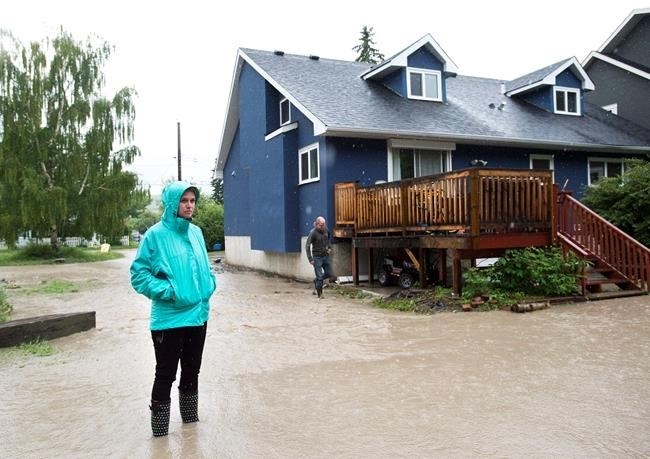
A woman walks stands in the backyard of her home in the flooded community of Bowness as up to 100,000 people have been evacuated from their homes, in Calgary, on June 21, 2013. The federal public safety minister says the government will open its wallet to help Canadians prepare for natural catastrophes spawned by extreme weather linked to climate change.
Image Credit: THE CANADIAN PRESS/Nathan Denette
January 14, 2016 - 7:00 AM
OTTAWA - The federal public safety minister says the government will open its wallet to help Canadians prepare for natural catastrophes spawned by extreme weather linked to climate change.
Devoting a portion of planned infrastructure spending to disaster readiness will not only stimulate the economy, but ensure communities are better able to deal with floods, forest fires, drought and ice storms, Ralph Goodale said in an interview with The Canadian Press.
"Weather events are going to get more severe, they're going to get more frequent, they're going to get more damaging," Goodale said.
"This is a very costly set of risks that are rising all of the time."
As part of its multibillion-dollar commitment to invest in a variety of infrastructure projects, the Liberal government has promised to spend money on climate-resilient public works.
That could mean building floodways and dikes to eliminate or reduce damage from a swollen river, constructing tornado-safe rooms or burying electrical cables to prevent ice buildup.
In recent years, parts of the Prairies have experienced severe swings, from flooding to drought and back again, "obviously flowing from the consequences of climate change," Goodale said.
"What kind of infrastructure do we need to put in place to be more effective in dealing with the problem of too much water one year and too little water the next? It presents an interesting challenge, but also an interesting set of opportunities in terms of economic development and growth."
Goodale's mandate letter from Prime Minister Justin Trudeau directs him to work with the provinces and territories, indigenous peoples and municipalities to develop a comprehensive action plan that allows Canada to better predict, prepare for and respond to weather-related emergencies and natural disasters.
"There's a wealth of knowledge and ability. At the moment, it's not very well co-ordinated," Goodale said. "So you've got to get all different orders of government working together here."
Despite the upfront costs, mitigation measures have yielded significant savings in Canada and worldwide, Public Safety officials have pointed out. For example, as of 2012, the Red River Floodway, built in the 1960s at a cost of $60 million, had been used over 20 times and prevented some $30 billion in damages.
The remoteness of indigenous communities, aging infrastructure on reserves and lack of money for emergency preparedness make these settlements more vulnerable to natural disasters, say internal Public Safety notes disclosed under the Access to Information Act.
One measure of a community's readiness is the ability of critical assets — such as water, power and communication grids — to recover quickly from a catastrophe.
But departmental officials are working to come up with a comprehensive set of "indicators of vulnerability and resilience" to identify high-risk areas in advance of disasters as well as the kinds of adverse events that severely strain a community, says an internal policy paper.
Without reliable measurements, "it will be difficult to target programs and resources to 'bake resilience in' or to demonstrate the benefits of doing so," the paper says.
News from © The Canadian Press, 2016